

Travelling by Train in China
Notable rail developments in the Far East
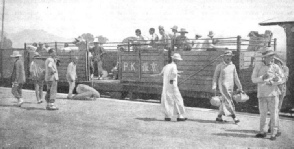 A TYPICAL SCENE on a Chinese railway platform showing the open box-
A TYPICAL SCENE on a Chinese railway platform showing the open box-
IN Great Britain, the majority of the people wanted railways as soon as they became available. In China the great mass of the population formerly objected to any form of locomotion other than that afforded by the wheel-
Most of the Western countries, however, acquired concessions, by one means or another, to build and operate railways in China. This vast country is now reasonably well served by lines that have been laid down by foreign engineers, and by the Chinese themselves.
An early railway in China is that linking Canton to Kowloon, adjoining the British island of Hong Kong. Canton is one of the most populous cities in Southern China, and hundreds of thousands of its inhabitants live in native boats or sampans that cover the river -
The British-
A concession was obtained to construct the line in 1898. and in 1906 the British section was begun. The standard gauge line is laid through difficult country, and great difficulty was experienced in securing native labour and making provision against floods.
Native customs and superstitions also militated against railway building. Ancestral graves, of which there are myriads scattered indiscriminately all over the countryside, could not be moved. The railway had to deviate to avoid them. For the same reason the hills could not be blasted just where required to make a way for the track.
More than a mile of tunnelling had to be resorted to, and this was accomplished by Italian engineers. About one-
The line was first opened for through traffic on August 5, 1911. The Canton-
One of the most important links in the whole of China’s railway systems is the Canton-
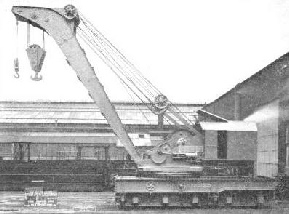 ON THE KOWLOON-
ON THE KOWLOON-
The beginning of this railway may be traced to the year 1896, when the scheme was first proposed. By 1904 an American syndicate had built a branch line from Canton westward to Samshui, a distance of thirty miles. International complications then arose, which stopped further progress until 1905. In that year local promoters raised sufficient capital to redeem the American concession. Construction of the line was then taken over by the Canton-
Work was begun at the Wuchang end in 1912, but, with the outbreak of the war, it was only possible to open the line as far as Changsha, a distance of 228 miles, in 1917. An extension of this line from Changsha to Chuchow due south for a distance of thirty miles was completed at the same time for the transport of coal. With the completion of the two end sections of the railway, the southern of 138 miles and the northern for a distance of 258 miles, a gap was left of 283 miles. This gap was destined to stay incomplete for a period of thirteen years, as it was found impossible to undertake the construction of a line through such extremely difficult country without adequate resources or the security afforded by settled government.
In 1929, however, the Chinese Ministry of Railways decided to resume work on the section from Shiuchow to Lochang for a distance of thirty-
In July 1933 work on the railway between Lochang and Chuchow was pushed forward vigorously, and the final link between northern and southern China is scheduled to be completed in 1936.
Another of the important lines in China is the Nanking-
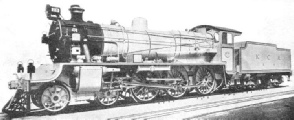 A 4-
A 4-
In 1865 it was proposed that this line should be built ostensibly as an object lesson to the Chinese in the construction and running of railways. The scheme was strenuously opposed, and had to be abandoned. Local interests, however, demanded a railway, and to overcome Celestial objections, a British company, Jardine Matteson & Co, obtained a concession from the Chinese Government to build a “road” along the proposed route. Land purchase for the scheme used up most of the Woosung Road Company’s capital, but in 1875 it was decided that a narrow-
At the beginning of construction, early in 1876, the Chinese Government protested that only a road had been sanctioned -
The remainder of the line was being laid when a Chinese was knocked down by the engine and killed. Riots ensued, and the line had to be closed. The Chinese Government, however, agreed to purchase the railway, which was reopened in December, 1876. When the final payment was made by the Chinese in October, 1877, all traffic was stopped. Shortly afterwards the rails were torn up and were shipped with the engines and carriages to the Island of Formosa, where they were dumped into the sea. A temple to the Queen of Heaven was erected on the site of the Shanghai Station.
The line was rebuilt by the Chinese in 1898, and later became part of Nanking-
The first section of the railway, from Shanghai to Nanziang, was opened in November, 1905, followed at intervals by the lines to Wusih, Changchow, Chinkiang, and finally to Nanking in March, 1908. Though most of the country between Shanghai and Nanking is flat, some 300 bridges and 400 culverts were built during the construction of the railway. Most of the bridges are of concrete, but about 2,000 tons of steel bridgework was erected, all of which came from England.
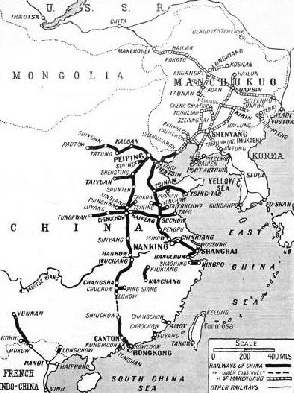 THE CHINESE NATIONAL RAILWAYS operate some 4,280 miles of standard gauge track, and 150 miles of metre-
THE CHINESE NATIONAL RAILWAYS operate some 4,280 miles of standard gauge track, and 150 miles of metre-
The whole of the land in the railway zone is closely cultivated, hut probably one-
The railway is to-
A remarkable offshoot of the Nanking-
Linking the Yangtze Valley with northern China are two main lines, one (the older line) from Hankow to Peking, now renamed Peiping, the other from Pukow to Tientsin. The Tientsin-
Before the opening of the Tientsin-
The Tientsin-
The British section was begun in 1908 and opened for traffic in 1912. This may be accounted excellent progress, as the period covers the Chinese Revolution, and the line was in the battle area.
Apart from this, the difficulties attending construction were considerable. In the first hundred miles from Pukow there are several long cuttings in the solid rock, and the maximum permissible gradient of 1 in 100 had to be resorted to for about forty miles.
A German-
Swamp ground necessitated the provision of high embankments, and on one stretch of flood land, five miles in length, the top of the embankment is 20 ft above ground level.
After the first hundred miles the country is practically flat, but some cuttings were needed to avoid detours in certain instances. The gauge is 4 ft 8½-
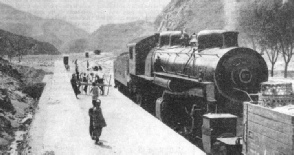 IN THE NORTH of China the line from the town of Kalgan runs for some miles parallel with the Great Wall. This photograph illustrates a halt at Chung-
IN THE NORTH of China the line from the town of Kalgan runs for some miles parallel with the Great Wall. This photograph illustrates a halt at Chung-
There are several bridges, the longest being that across the Hwai River, with nine spans of 200 ft. Another bridge, at Ise Ho, has five spans of 200 ft and three of 50 ft. There are extensive railway workshops situated within the city of Pukow. The old city wall boundary encloses the buildings on two sides.
The northern end of the Tientsin-
Construction work on the German section was begun on July 1, 1908, and the first through train service ran on December 1, 1912, although some portions of the line were opened for traffic in November, 1910. In particular the line from Tientsin to Tsinan was opened before the end of 1910, and did a good traffic with the east coast via the Kiaotsi Railway. At the same time a junction was made with the Peking-
The materials used on the German section naturally came from Germany. The engineers’ method of providing ballast for the track is interesting. The line runs through a great plain devoid of hard stone, but abounding in alluvial deposits and loess. A number of kilns were built along the route, and in these the available material was burnt to a clinker, and finally broken up into ballast. Only the lower bricks in the kilns were hard enough to form ballast, but the remainder were used to build the station houses and platforms.
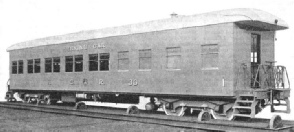 FIRST-
FIRST-
The kilns were used also for the making of tiles, moulded to artistic shapes, which lent a pleasing and typically Chinese aspect to the railway buildings.
There are no tunnels on the Pukow-
In 1897 two German missionaries were murdered by Chinese in Shantung. A German squadron thereupon took possession of Kiaochow Bay and the surrounding country. After the settlement of this incident with the Chinese Government, a concession was granted to Germany to build two railways in Shantung, and mining rights were acquired.
A line was built from the port of Tsing-
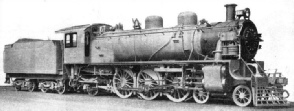
“PACIFIC” TYPE LOCOMOTIVE built for the Tientsin-
We have seen how many of China’s railways sprang from concessions granted for one reason or another to foreign powers. One line in China, however, grew with the necessity of transporting coal from the Kaiping coalfields. These mines were first developed in 1878, and although the coalfields extend to the sea, an ice-
All efforts to persuade the Chinese to sanction a railway had failed, but a canal was constructed from the Pehtang River to a point seven miles from the colliery. Finally the Chinese authorities consented to the construction of a line, to be called the Kaiping Tramway, and operated by mules.
The engineer of the Chinese Engineering and Mining Company, Mr. C. W. Kinder, decided to build this “tramway” to standard gauge. On completion of the track Mr. Kinder began to build a locomotive at Tongshan, using materials from the colliery scrap-
The engine frame was built up of channel iron from old pit head-
The reason for building the locomotive was that if the engineer had attempted to import one into China there would have been riots, and his “tramway” would have shared the fate of the Woosung “road” referred to earlier in this chapter.
Work on the engine was suspended several times, and it is said that on one occasion the incomplete machine was buried in the ground so that Chinese officials should remain unaware of its presence.
Defeating the Floods
In June, 1881, however, the little locomotive started work on the tramway, which was extended about five years later along the side of the canal, to Lutai, where it now forms part of the main line. In August, 1888, the railway reached Tientsin, and extensions were made to the Great Wall of China at Shanhaikwan and to Tungchow, twelve miles from Peking.
The main line, including a fifty-
The railway was finished after the Russo-
There are certain branch lines north of Peking, one of the most important being the Peking-
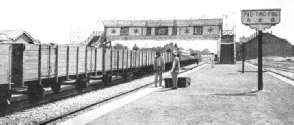
ON THE PEKING-
From Nankow, thirty-
Apart from the tunnelling, the railway embankment had to be protected by stone facing and walls from the action of the river when in flood. Once through the pass, the engineers encountered no further difficulties in building the remainder of the line to Kalgan.
In contrast with other railways in China this line does not pass through flood lands, and stone for ballasting and other purposes is plentiful. Little bridge construction was needed, and the largest bridge is one with a single 100 ft span.
An agreement for the building of the South Manchurian Railway was entered into by Russia and China in September, 1896. From its inception the political forces behind the move were of far greater importance than considerations of transport.
The line, built by Russian engineers with Russian capital, was transferred to Japan by the Treaty of Portsmouth in 1905. The South Manchurian Railway runs from Darien on the Yellow Sea (with a branch to Port Arthur), through Mukden (Shenyang) to Hsinking (formerly Changchun) in Manchukuo, formerly Manchuria. Mukden is the northern terminus of the Chinese Government railways, and Hsinking is at the southern end of the Chinese Eastern Railway, also built by the Russians. The Chinese Eastern Railway was built to a gauge of 5 ft, and really forms an extension of the Trans-
The South Manchurian line was completed in 1901. Early in the progress of the Russo-
In South Manchuria
At the same time the Japanese built a light 2 ft 6-
After the transfer of the South Manchurian Railway to Japan, a company, under the control of the Japanese Government, was formed, not only to take over the administration of the railway, but also to administer South Manchuria on behalf of Japan. This was in 1906, and provides an interesting sidelight on the formation, in 1934, of the state of Manchukuo.
The first task of the new company was to widen the line from Dairen to Changchun -
In 1909 the Japanese began the rebuilding of the narrow-
The rebuilding of this branch completed the conversion of the South Manchurian Railway to standard gauge, but, because of a curious oversight, through running to Chinese lines at Mukden was not possible. South Manchurian rolling stock was 8½-
Construction of the main line from Changchun to Dairen did not present quite so difficult a task as work subsequently carried out on the railway, as the country presents few natural obstacles, and permits a maximum gradient of 1 in 100.
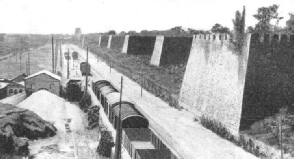
THE EVIDENCE OF TWO CIVILIZATIONS can be seen in this remarkable picture of the old city wall at Peking with the railway track laid alongside it. Peking is the meeting-
Dairen is laid out on modern lines and has a regular steamer service to Shanghai. The railway workshops at Dairen are fully equipped for constructing and repairing locomotives and rolling stock.
In addition to the railway linking Nanking and Peking, there is an older route between the Yangtze River and the former capital of China. This is known as the Peking-
Definite proposals to link Hankow and Peking by rail were put forward in 1895, and a survey of the route was begun the following year by an American syndicate. The survey was completed in March, 1897, but neither the Americans nor the British were successful in the final negotiations with the Chinese authorities, since the concession to build the railway went to the Belgians.
A protest was lodged by British merchants with interests in the locality, and concessions were obtained for lines radiating from Shanghai, for the Canton-
The work of the Belgian engineers began in 1900. A section of line, from Lukouchiao to Paoting, had already been built about 1896 by Britain. This line, about eighty miles in length, was taken over by the Belgians. During the international military occupation necessitated by the Boxer Rebellion of 1900, French engineers carried the line from Lukouchiao to Chien-
The distance from Paoting to Hankow -
“China’s Sorrow”
There are few cuttings on the route and the lines are laid on the ground, following its contour, so that the rails can be seen for miles, glistening in the sun and undulating with the countryside.
It was necessary to construct two tunnels on the Peking-
The Yellow River is known justifiably as “China’s Sorrow”, and changes its course at irregular intervals, generally with enormous loss of life. The changes are so complete that the old beds of the river can be seen several hundreds of miles apart. This erratic behaviour is due to the fact that the river flows on an elevated part of the country with a sandy soil, and has no rock or clay in the formation of its banks for hundreds of miles. The railway does not descend into the river “valley” but rises to meet it.
Building a bridge across such a river proved no light undertaking, especially as the bed is of shifting sand, with two deep “scours” or channels where the current is very strong. These “scours” will sometimes be increased in depth by floods to the extent of some ten or twelve feet.
The Belgian engineers decided to construct their bridge on “screw” piles, so that in the event of a change in the river’s course at the site chosen, it would be possible to re-
There are 102 spans, carried on girder-
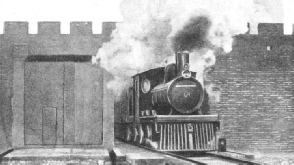 A LINE THROUGH A CITY WALL. A Hankow train passing through an ancient rampart at Peking. The building of a through line between the two cities was chiefly the work of British, Belgian, and French engineers. One section of the line was completed as far back as 1896.
A LINE THROUGH A CITY WALL. A Hankow train passing through an ancient rampart at Peking. The building of a through line between the two cities was chiefly the work of British, Belgian, and French engineers. One section of the line was completed as far back as 1896.
The Peking-
We have been considering Chinese railways of the plains, where construction has constituted a battle of bridges against floods. The Cheng-
Three-
Another line in the province of Honan is that running west from Tsinghwa to Taokow, and this may be regarded as an offshoot of the Peking-
French Indo-
A concession to build the line was granted to the Peking Syndicate in 1900, to link the mines of that concern with the Peking-
The line, completed in 1905, is ninety-
The route lies in somewhat flat country and, although a number of bridges were necessary, none of these is of large dimensions. There are some fine repair shops attached to the railway, which is joined to the mining property of the Peking syndicate by a branch line 1,000 yards long.
Another railway that crosses the Peking-
There are eleven tunnels varying in length from 54 yards to 546 yards, and 403 bridges of both steel and stone. One of the finest of the steel bridges is that over the Lo Ho, completed in 1910, and this structure has seven spans with a total length of 345 yards.
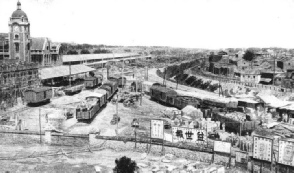
AT PEKING, the former capital of China, a view of the recently built junction and goods sidings. To the left can be seen a half-
French Indo-
Unfortunately, however, Yunnan comprises some country presenting great difficulty to the railway engineer. Great mountain ranges, towering 4,000 to 7,000 ft, are intersected by deep, precipitous ravines in which flow swift rivers. To overcome this great natural barrier, the French Government obtained a concession to build a railway from the frontier to Yunnan-
The line is built to the metre gauge, and is laid on steel sleepers. Great trouble was experienced in construction, as the mountains through which the railway winds are composed of rock interspersed with layers of clay in some places. In the rainy season it was a common occurrence for great overhanging masses of rock to break away and smash the track. One of the most spectacular feats of engineering on the Yunnan Railway was the crossing of the gorge through which flows the Faux Nan-
The building of the line necessitated the bridging of this chasm, a distance of 215 ft between the opposite cliff faces at a height of 335 ft above the stream. To gain access to the cliff faces, tunnels were driven through the rock on both sides of the gorge. The steel bridge linking the tunnel mouths is of remarkable design and construction.
Engineering Triumph
Two triangular-
The Yunnan line was completed in 1910 after some eight years of struggle against the forces of Nature, and in the face of labour troubles, coupled with financial and technical difficulties. Another line runs from Hanoi into the Yunnan province at Lungchow.
Another important line in China is the Shanghai-
Construction was begun in 1906 and the line was opened for traffic to Hangchow in August 1909. By 1935 the line from Ningpo towards Hangchow had been completed as tar as Pokwan. The line had also been built out from Hangchow for a short distance in the direction of Pokwan.
Part of the scheme for the final linking of the line from Shanghai through Hangchow to Ningpo is a great steel bridge across the Tsiantong Kiang River, the contract for which has been placed with a British firm.
Some of the enormous difficulties under which railway builders accomplished their great tasks have been outlined above, but the hidden obstacles against which railway construction was faced can be appreciated only by a knowledge of the country itself.
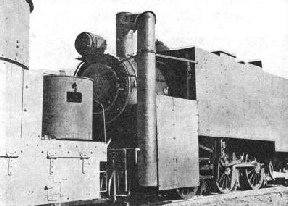
ARMOURED TRAINS are sometimes used by the Chinese army. This picture shows a train near Ho-
In 1918 the Chinese Ministry of Communications began to put in hand a system of unification among the various interests in the Chinese railway world. Between the years 1917 and 1922 a careful study was made of standardization. Large numbers of 40-
Of the principal lines now serving the country the Peking-
You can read more about
and
and
on this website.
You can read more on the
in Wonders of World Engineering.